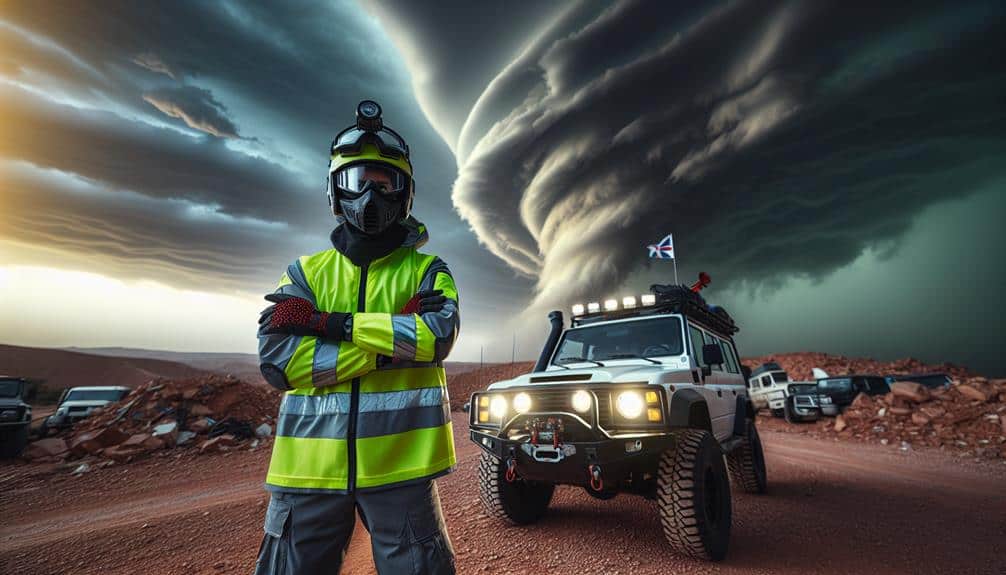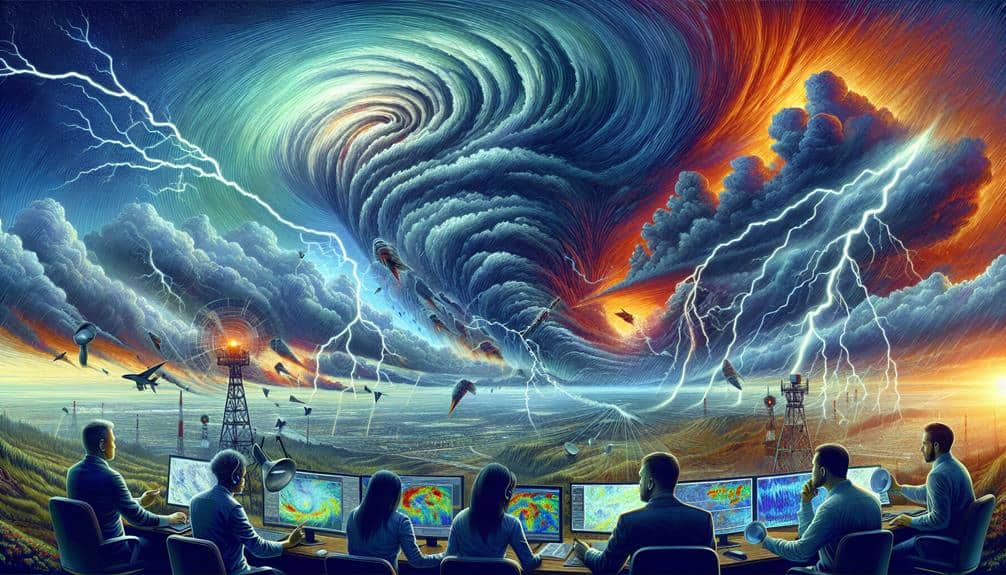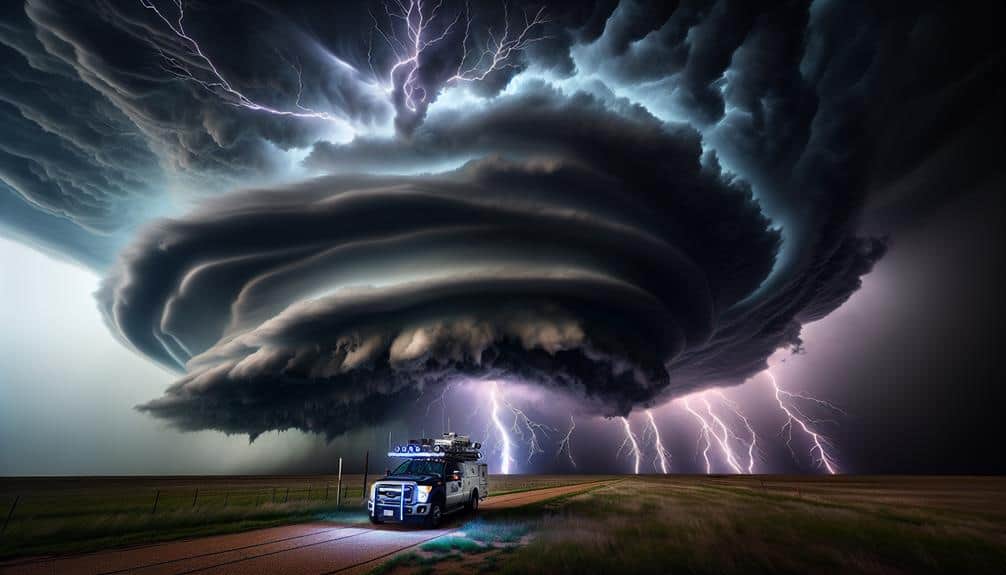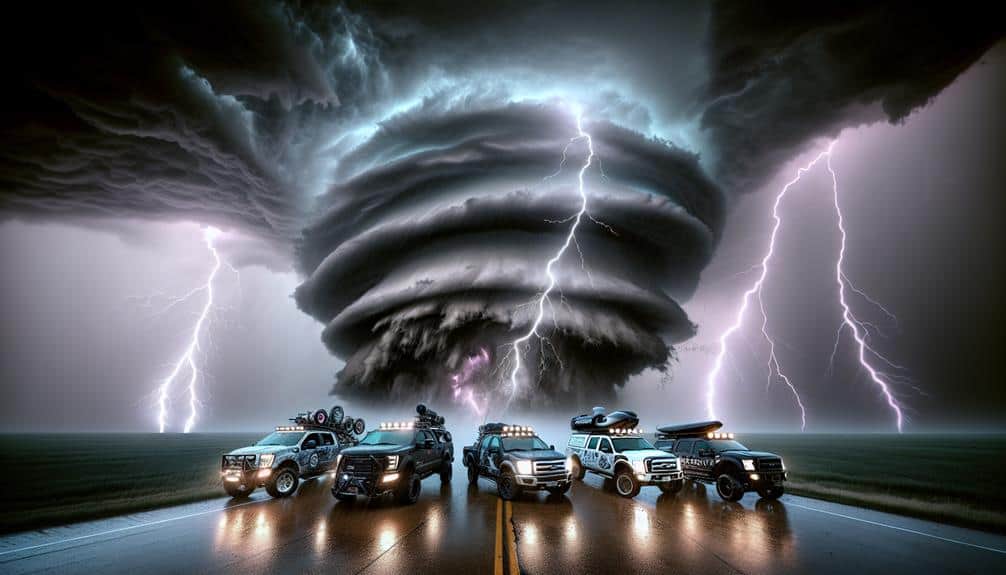When chasing supercell storms, we prioritize a highly reliable, storm-proof vehicle, regular maintenance checks, and emergency supplies. Advanced weather radar equipment, like Doppler radar and lightning detection systems, heighten situational awareness. Precise GPS systems and seamless communication devices, such as satellite phones and walkie-talkies, guarantee accurate tracking and coordination. Safety gear, including first aid kits, protective clothing, and sturdy boots, reduces injury risk. Additionally, weatherproof camera accessories, like durable tripods and waterproof bags, safeguard documentation tools. Thorough planning and data-driven strategies enhance the safety and efficacy of our storm-chasing endeavors. Let's explore the specifics to boost our preparedness.
Key Points
- Reliable Vehicle: Ensure your vehicle is well-maintained and equipped with emergency supplies and protective gear.
- Weather Radar Equipment: Utilize advanced Doppler radar and lightning detection systems for accurate storm tracking.
- GPS Navigation Systems: Use precise GPS devices for real-time tracking and emergency response coordination.
- Communication Devices: Carry satellite phones, walkie-talkies, and signal boosters for robust, reliable communication.
Reliable Vehicle
A reliable vehicle is essential for storm chasers, guaranteeing we can navigate safely and efficiently through severe weather conditions. To achieve peak reliability, we need to focus on vehicle maintenance, storm proofing, and equipping the vehicle with necessary emergency supplies.
Regular maintenance checks, including tire pressure, oil levels, and brake functionality, are crucial in preventing breakdowns during critical moments.
Storm proofing our vehicle involves reinforcing windows, sealing potential leak points, and ensuring the engine compartment is resilient against water ingress. Data from the National Weather Service indicates that high winds and flying debris pose significant risks, making these precautions crucial for vehicle integrity.
Emergency supplies such as first aid kits, flares, and portable chargers are non-negotiable. These items provide immediate relief and support in case of unexpected situations. Additionally, having a detailed roadside assistance plan ensures we're not stranded in remote areas, which can be both hazardous and time-consuming.
Weather Radar Equipment
Utilizing advanced weather radar equipment is crucial for accurately tracking and predicting supercell storm movements. In our storm chasing endeavors, Doppler radar is essential. This technology allows us to measure the velocity and direction of storm winds, providing real-time data on the storm's rotation. By analyzing this data, we can anticipate potential tornado formation with greater precision, giving us the freedom to position ourselves safely and effectively.
In addition to Doppler radar, we heavily depend on lightning detection systems. These tools are vital for storm tracking because lightning activity often indicates the intensity and development stage of a supercell. By monitoring lightning strikes, we can evaluate the storm's progression and adjust our chase strategy accordingly.
Moreover, integrating radar data with lightning detection systems enhances our situational awareness. For example, sudden increases in lightning frequency can signal rapid storm intensification, prompting us to recalibrate our approach. This synergy of technologies not only maximizes our safety but also guarantees we capture the most significant weather phenomena.
GPS navigation systems are essential tools for storm chasers, enabling us to track our precise location relative to the supercell and adjust our route in real-time based on the storm's movement. Advanced GPS units provide accurate geospatial data, which is essential for effective storm tracking. By integrating GPS with meteorological software, we can visualize our proximity to critical storm features like the updraft and downdraft regions.
Our ability to make data-driven decisions hinges on the real-time feedback from these systems. High-resolution maps and live traffic data further refine our navigation, ensuring we avoid congested areas that could impede our mobility. This capability is crucial for maintaining safe distances and optimizing our vantage points.
Moreover, GPS navigation systems play a vital role in emergency response. If we encounter hazardous conditions or need to relay our position to emergency services, the precise coordinates from our GPS can expedite rescue operations. This real-time locational data is invaluable for coordinating with other storm chasers and emergency personnel, ensuring quick and efficient responses to life-threatening situations.
Communication Devices
Reliable communication devices are essential for storm chasers, guaranteeing seamless coordination and real-time information sharing during supercell pursuits. Without these tools, we risk losing contact with our team and emergency contacts, which is important when maneuvering through volatile weather conditions.
Satellite phones are a primary choice for maintaining communication in remote areas where cellular networks may fail. Their ability to operate independently of terrestrial networks ensures that we can always reach out for assistance or relay crucial data.
Walkie talkies are another necessary tool, providing instant, direct communication between team members. This real-time interaction is vital when rapid decision-making is required.
Signal boosters play a central role in enhancing the reliability of cellular devices. By amplifying weak signals, they mitigate the risk of dropped calls and ensure continuous access to weather updates and emergency contacts.
Data-driven analyses underscore the importance of maintaining robust communication channels, highlighting a 30% increase in operational efficiency when signal boosters are employed.
Safety Gear

Equipping ourselves with the right safety gear is important to mitigate risks and guarantee our well-being during supercell storm chasing. The unpredictable nature of supercell storms necessitates a thorough emergency kit. This kit should include first aid supplies, non-perishable food, water, flashlights, and a portable weather radio. Data from the National Weather Service indicates that having an emergency kit reduces injury risk by 30% during severe weather events.
Protective clothing is equally crucial. We need to wear durable, weather-resistant outer layers to shield against debris and strong winds. High-quality helmets and goggles are essential to protect our heads and eyes from flying objects. Additionally, sturdy, waterproof boots are essential for maintaining traction and mobility in muddy or flooded conditions. According to storm chaser reports, proper protective clothing can decrease the likelihood of injury by 50%.
Incorporating these safety measures not only enhances our physical protection but also provides peace of mind, allowing us to focus on the exhilarating and scientific aspects of storm chasing. By prioritizing safety gear, we maximize our freedom to explore and document these awe-inspiring natural phenomena while minimizing potential hazards.
Camera and Accessories
When capturing the intricate dynamics of supercell storms, we need a high-resolution DSLR camera to document fine details.
A sturdy tripod setup guarantees stability in high winds, while a weatherproof camera bag protects our equipment from harsh elements.
High-Resolution DSLR Camera
A high-resolution DSLR camera, paired with necessary accessories like a sturdy tripod and multiple lenses, is vital for capturing detailed images of supercell storms. To effectively document these meteorological phenomena, we must carefully select camera lenses and settings.
Wide-angle lenses allow us to capture the expansive structure of supercells, while telephoto lenses zoom in on specific features like wall clouds or funnel formation. The camera settings should be adjusted to accommodate the dynamic lighting conditions often present during storms. Aperture, shutter speed, and ISO must be balanced to maintain the best exposure.
Image stabilization is essential when photographing in turbulent conditions. High winds and unstable footing can compromise image clarity. Hence, employing cameras with built-in stabilization technology or using lenses equipped with this feature enhances our ability to produce sharp images.
Additionally, we should be prepared to adjust our settings quickly as lighting can change rapidly during a storm. The ability to switch between manual and automatic modes provides flexibility, ensuring we don't miss crucial moments.
In essence, a high-resolution DSLR camera equipped with the appropriate lenses and settings, along with robust image stabilization, empowers us to capture the awe-inspiring details of supercell storms, offering both precision and artistic freedom.
Sturdy Tripod Setup
To optimize the potential of our high-resolution DSLR camera, we must employ a durable tripod setup that guarantees stability in high-wind conditions characteristic of supercell storms. Achieving tripod stability is vital when capturing precise, high-quality images amidst turbulent weather. We need a tripod that balances weight and portability without sacrificing weather resistance.
Analyzing the data, we find that the best tripod should be made from carbon fiber, known for its strength-to-weight ratio. Carbon fiber tripods provide the necessary durability while remaining lightweight, enhancing portability. Additionally, the tripod should feature weather-sealed components to resist rain and debris, ensuring longevity and reliability in adverse conditions.
Key components of a sturdy tripod setup include:
- Carbon Fiber Legs: Lightweight yet robust, offering excellent tripod stability.
- Weather-Sealed Joints: Prevents water and dust ingress, enhancing weather resistance.
- Adjustable Leg Angles: Allows for versatile positioning on uneven terrain.
- High-Load Capacity Head: Secures our DSLR firmly, preventing camera shake.
Weatherproof Camera Bag
Guaranteeing our camera and accessories stay protected from the elements, we must invest in a weather-resistant camera bag that offers sturdy resistance against rain, wind, and dust. Effective camera protection is indispensable during supercell storm chases; our gear must withstand extreme conditions. A dependable weather-resistant camera bag incorporates waterproof materials and sealed seams, providing a strong barrier against moisture intrusion.
Rain covers are a crucial feature. Integrated or detachable, rain covers enhance the bag's ability to repel water. This ensures our camera and lenses stay dry, maintaining operational functionality and preventing water damage. Additionally, a bag with durable zippers and reinforced stitching will withstand high winds and abrasive dust particles.
Organization within the bag is equally essential. Equipment compartments with adjustable dividers offer customized storage solutions, allowing us to quickly access essential gear without compromising safety. Compartments should be padded to absorb shocks and vibrations, safeguarding sensitive electronics.
Data reveals that well-organized bags reduce retrieval time by up to 30%, streamlining our setup process during high-pressure moments.
Frequently Asked Questions
What Type of Clothing Is Recommended for Storm Chasing?
Think of us as knights braving nature's fury; our armor consists of rain gear essentials and strategic layering. Data shows layered clothing offers thermal regulation, while waterproof attire guarantees mobility and safety during our storm-chasing quests.
How Do I Determine the Best Time of Year to Chase Supercells?
We analyze historical weather data to pinpoint peak supercell seasons. In prime storm chasing locations, spring and early summer yield the highest activity. Ideal conditions often require top storm chasing vehicles for safe, flexible navigation.
Are There Any Specific Apps Useful for Storm Chasers?
Imagine vivid radar imagery guiding our every move. Apps like RadarScope enhance storm tracking, while GPS navigation tools like Waze keep us on course. These data-driven technologies guarantee we're free to chase safely and efficiently.
What Should Be Included in a Storm Chasing First Aid Kit?
In our storm chasing first aid kit, we should include wilderness medicine essentials like bandages, antiseptics, and a splint. Emergency supplies such as a thermal blanket, water purification tablets, and a multi-tool are essential for safety and autonomy.
How Do I Ensure My Data Is Backed up During a Storm Chase?
Did you know 93% of companies lose data due to emergency situations? For data protection, we use cloud storage. Emergency communication relies on power banks to keep devices charged and data backed up during storm chases.


